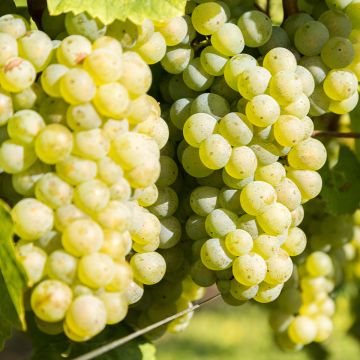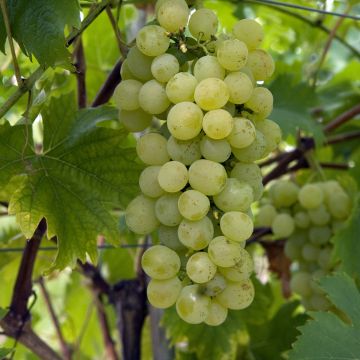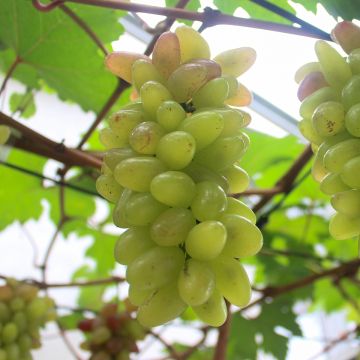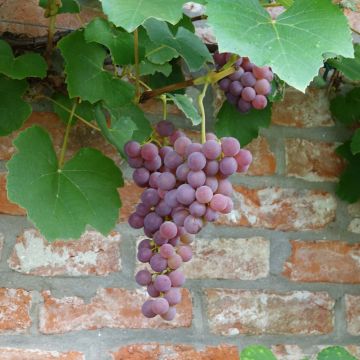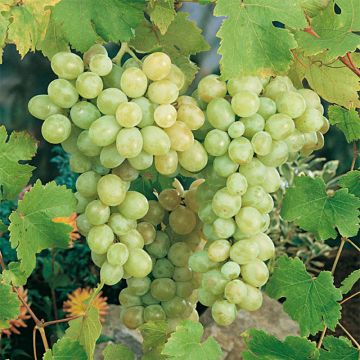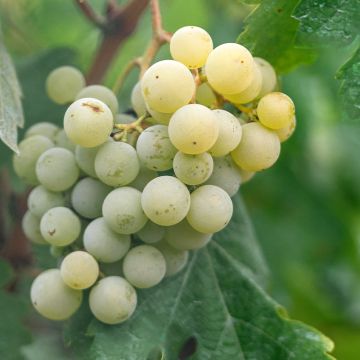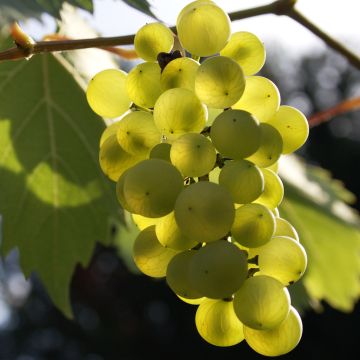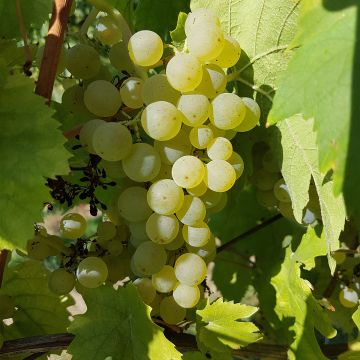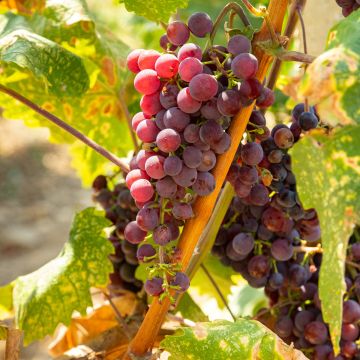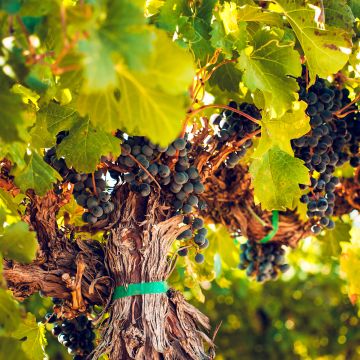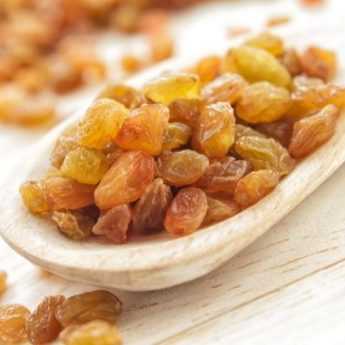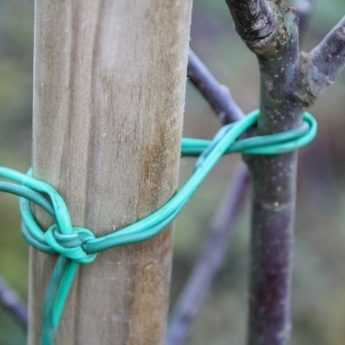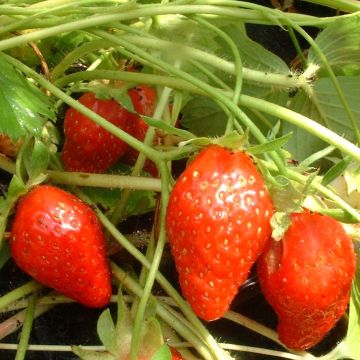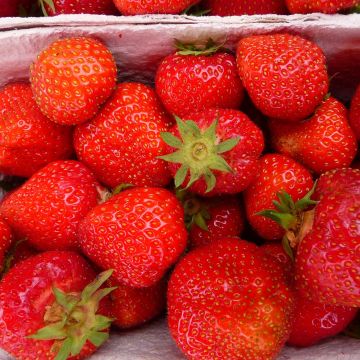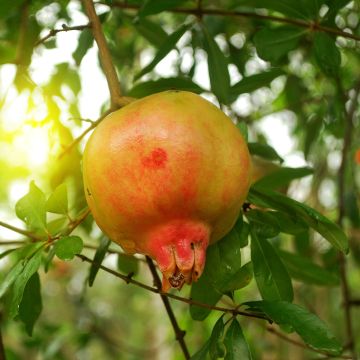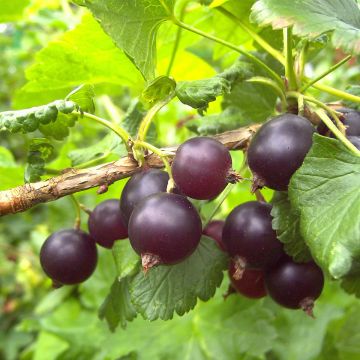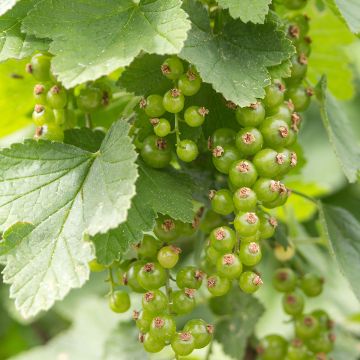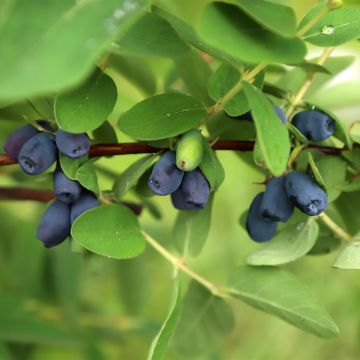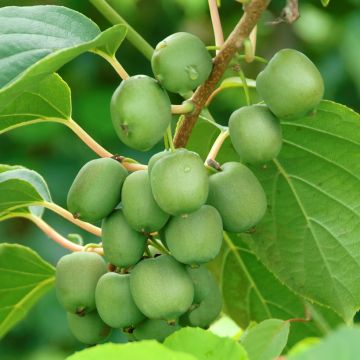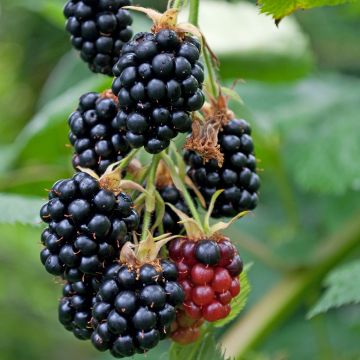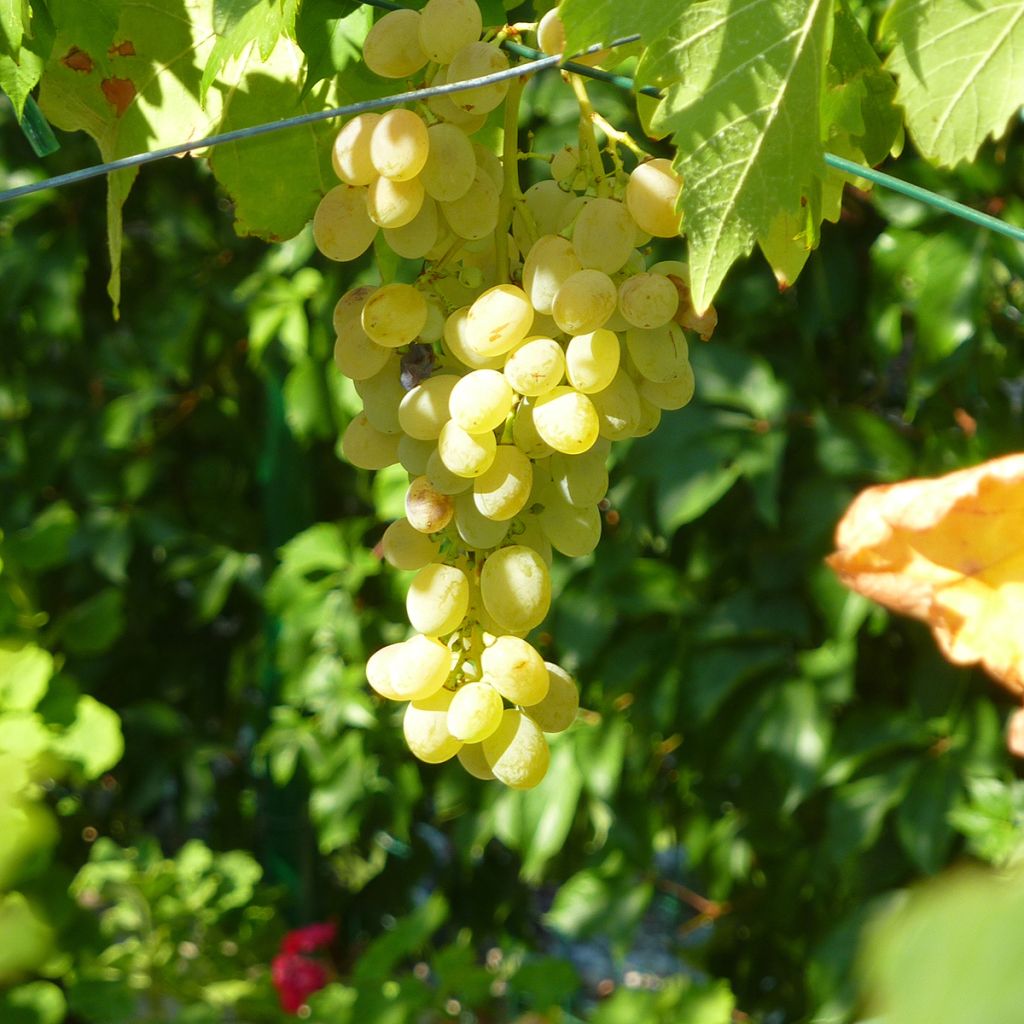

Vitis vinifera Corniola - Grapevine
Vitis vinifera Corniola - Grapevine
Vitis vinifera Corniola
Common Grape Vine, European Grape, Wine Grape
Home or relay delivery (depending on size and destination)
Schedule delivery date,
and select date in basket
This plant carries a 6 months recovery warranty
More information
We guarantee the quality of our plants for a full growing cycle, and will replace at our expense any plant that fails to recover under normal climatic and planting conditions.
Description
The 'Corniola' Table Grape is an old, rare, small and productive variety with rapid growth. Its fruit clusters are large, conical, often winged. Its grapes are elongated and slightly asymmetrical, pinkish-yellow with a very sweet taste, crisp and juicy flesh, and thick skin. The plant is quite hardy, to approximately -18°C. It prefers a warm and sheltered location. The root system is resistant to phylloxera, and the foliage offers good resistance to fungal diseases.
The wine grape (Vitis vinifera) grew wild over 5000 years ago in North and Central America, Europe, and Central and Eastern Asia. The subspecies sylvestris still exists, it is a climbing vine, growing on the edge of forests and capable of reaching great heights in trees. The current varieties are classified under the subspecies vinifera (although there are other cultivated species, but they are very minor). Economically, wine grapes predominate over table grapes.
'Corniola' is an old variety of white table grape found in Italy, where it likely originated from the Middle East in the 1920s. Corniola is a vigorous climbing shrub with an upright habit that reaches only 1.5 to 2m high with a similar width if not pruned. It needs to be trained on a trellis, which it can cover quite quickly. Its foliage is a beautiful matte light green, with three or five-lobed leaves, toothed all around. Like most grapes, it is self-fertile. It flowers in May-June depending on the year and region, with very small greenish flowers.
These develop into large clusters. The berries are large and elongated, initially greenish-yellow and turning pinkish-yellow when ripe. These fruits are ready to be harvested around mid-September. They are sweet and juicy with thick skin. This variety is relatively resistant to diseases. It is useful to summer prune the vine to remove certain leaves so that the grapes are well exposed to the sun and can acquire that beautiful golden colour, a sign of their taste quality.
The 'Corniola' grape can be consumed fresh or as juice, for example in a vitamin-packed fruit cocktail for breakfast. In general, grapes are rich in vitamin B, a source of fibre and manganese, and they are also rich in antioxidants. They are believed to play a role in preventing cardiovascular diseases and are a healthy, natural, and delicious dessert. To create original fruit salads, sow Cape Gooseberry or Peruvian Ground Cherry (Physalis peruviana) in late spring to harvest its amazing orange fruits from August to October. And to enjoy grapes for a long period, plant other varieties of vines that ripen at different times.
Report an error about the product description
Vitis vinifera Corniola - Grapevine in pictures
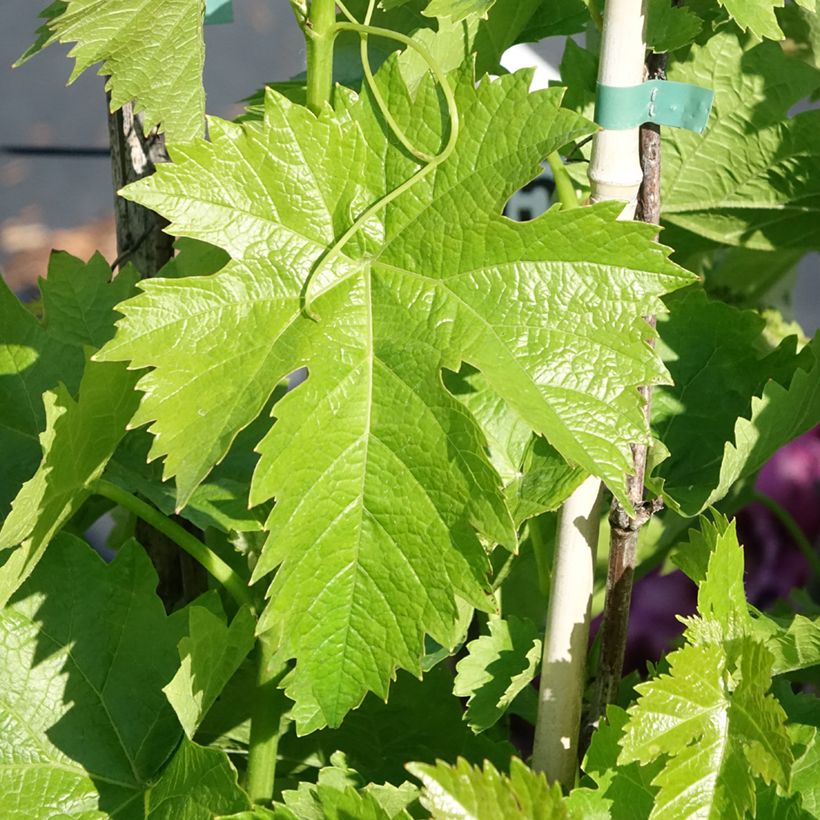

Plant habit
Fruit
Flowering
Foliage
Botanical data
Vitis
vinifera
Corniola
Vitaceae
Common Grape Vine, European Grape, Wine Grape
Middle East
Other Grapevines
View all →Planting and care
Since the devastation caused by phylloxera at the end of the 19th century, the vine is grafted onto different rootstocks, resistant to this disease and adapted to different types of soil. These rootstocks come from American varieties naturally armed against this formidable parasite, itself of American origin.
Plant the Corniola table vine in autumn, in deep, well-drained, even stony, clayey and chalky soil, the vine is not undemanding in terms of the chemical nature of the soil. It is capable of adjusting to moderately acidic soil (up to pH 6 approximately, because below that there are assimilation blockages of certain trace elements), neutral and chalky up to pH 8.5 approximately (it is the excess of active lime that is harmful).
Plant it in a sunny location, sheltered from strong, cold and dry winds. This variety can withstand winter frosts, it is very hardy down to -18°C. Incorporate 3 or 4 handfuls of fertiliser for fruit trees and 2 kg of composted manure into the planting soil for each vine. Be careful, the roots should not come into contact with the manure. After planting, prune above 2 large buds (buds) to obtain two branches. Keep the most vigorous one, and tie it to a stake. Training pruning will follow below.
The vine does not require regular fertiliser application, for good yield, on the contrary. In too-rich soil, vegetation (leaves) will develop at the expense of fruiting. Enrich the soil with potash, crushed horn or iron chelate, only every 2-3 years.
This variety is highly resistant to classic vine diseases, including powdery mildew.
Planting period
Intended location
Care
Planting & care advice
This item has not been reviewed yet - be the first to leave a review about it.
Similar products
Haven't found what you were looking for?
Hardiness is the lowest winter temperature a plant can endure without suffering serious damage or even dying. However, hardiness is affected by location (a sheltered area, such as a patio), protection (winter cover) and soil type (hardiness is improved by well-drained soil).

Photo Sharing Terms & Conditions
In order to encourage gardeners to interact and share their experiences, Promesse de fleurs offers various media enabling content to be uploaded onto its Site - in particular via the ‘Photo sharing’ module.
The User agrees to refrain from:
- Posting any content that is illegal, prejudicial, insulting, racist, inciteful to hatred, revisionist, contrary to public decency, that infringes on privacy or on the privacy rights of third parties, in particular the publicity rights of persons and goods, intellectual property rights, or the right to privacy.
- Submitting content on behalf of a third party;
- Impersonate the identity of a third party and/or publish any personal information about a third party;
In general, the User undertakes to refrain from any unethical behaviour.
All Content (in particular text, comments, files, images, photos, videos, creative works, etc.), which may be subject to property or intellectual property rights, image or other private rights, shall remain the property of the User, subject to the limited rights granted by the terms of the licence granted by Promesse de fleurs as stated below. Users are at liberty to publish or not to publish such Content on the Site, notably via the ‘Photo Sharing’ facility, and accept that this Content shall be made public and freely accessible, notably on the Internet.
Users further acknowledge, undertake to have ,and guarantee that they hold all necessary rights and permissions to publish such material on the Site, in particular with regard to the legislation in force pertaining to any privacy, property, intellectual property, image, or contractual rights, or rights of any other nature. By publishing such Content on the Site, Users acknowledge accepting full liability as publishers of the Content within the meaning of the law, and grant Promesse de fleurs, free of charge, an inclusive, worldwide licence for the said Content for the entire duration of its publication, including all reproduction, representation, up/downloading, displaying, performing, transmission, and storage rights.
Users also grant permission for their name to be linked to the Content and accept that this link may not always be made available.
By engaging in posting material, Users consent to their Content becoming automatically accessible on the Internet, in particular on other sites and/or blogs and/or web pages of the Promesse de fleurs site, including in particular social pages and the Promesse de fleurs catalogue.
Users may secure the removal of entrusted content free of charge by issuing a simple request via our contact form.
The flowering period indicated on our website applies to countries and regions located in USDA zone 8 (France, the United Kingdom, Ireland, the Netherlands, etc.)
It will vary according to where you live:
- In zones 9 to 10 (Italy, Spain, Greece, etc.), flowering will occur about 2 to 4 weeks earlier.
- In zones 6 to 7 (Germany, Poland, Slovenia, and lower mountainous regions), flowering will be delayed by 2 to 3 weeks.
- In zone 5 (Central Europe, Scandinavia), blooming will be delayed by 3 to 5 weeks.
In temperate climates, pruning of spring-flowering shrubs (forsythia, spireas, etc.) should be done just after flowering.
Pruning of summer-flowering shrubs (Indian Lilac, Perovskia, etc.) can be done in winter or spring.
In cold regions as well as with frost-sensitive plants, avoid pruning too early when severe frosts may still occur.
The planting period indicated on our website applies to countries and regions located in USDA zone 8 (France, United Kingdom, Ireland, Netherlands).
It will vary according to where you live:
- In Mediterranean zones (Marseille, Madrid, Milan, etc.), autumn and winter are the best planting periods.
- In continental zones (Strasbourg, Munich, Vienna, etc.), delay planting by 2 to 3 weeks in spring and bring it forward by 2 to 4 weeks in autumn.
- In mountainous regions (the Alps, Pyrenees, Carpathians, etc.), it is best to plant in late spring (May-June) or late summer (August-September).
The harvesting period indicated on our website applies to countries and regions in USDA zone 8 (France, England, Ireland, the Netherlands).
In colder areas (Scandinavia, Poland, Austria...) fruit and vegetable harvests are likely to be delayed by 3-4 weeks.
In warmer areas (Italy, Spain, Greece, etc.), harvesting will probably take place earlier, depending on weather conditions.
The sowing periods indicated on our website apply to countries and regions within USDA Zone 8 (France, UK, Ireland, Netherlands).
In colder areas (Scandinavia, Poland, Austria...), delay any outdoor sowing by 3-4 weeks, or sow under glass.
In warmer climes (Italy, Spain, Greece, etc.), bring outdoor sowing forward by a few weeks.



































